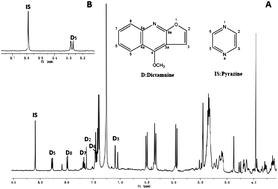Dictamni Cortex (Baixianpi) is a commonly used medicinal herb in traditional Chinese medicines (TCMs), possessing various bioactivities. Quinoline alkaloids are regarded as one of the main active components in this herb. In the present study, a more convenient, specific and accurate analytical method using 1H NMR has been developed for the quantitative determination of dictamnine, one of the main active quinoline alkaloids in Dictamni Cortex. In a less crowded region δ 8.0–8.5, the signal of H-5 of dictamnine was well separated from other signals in chloroform-d1. The quantity of dictamnine was calculated by means of the integral value of H-5 of dictamnine to that of the known amount of internal standard, pyrazine. This assay was precise and reproducible, with RSDs less than 3%. The recovery results of dictamnine were observed between 92.10 and 108.10% and the limit of detection (LOD) and limit of quantitation (LOQ) were 3.3 μg ml−1 and 13.2 μg ml−1, respectively. This newly developed method was proven to be highly accurate, precise and robust, for the determination of dictamnine in Dictamni Cortex. The results obtained from 1H NMR method were also compared with those from conventional HPLC method, and no remarkable difference was found between these two methods.

You have access to this article
 Please wait while we load your content...
Something went wrong. Try again?
Please wait while we load your content...
Something went wrong. Try again?


 Please wait while we load your content...
Please wait while we load your content...